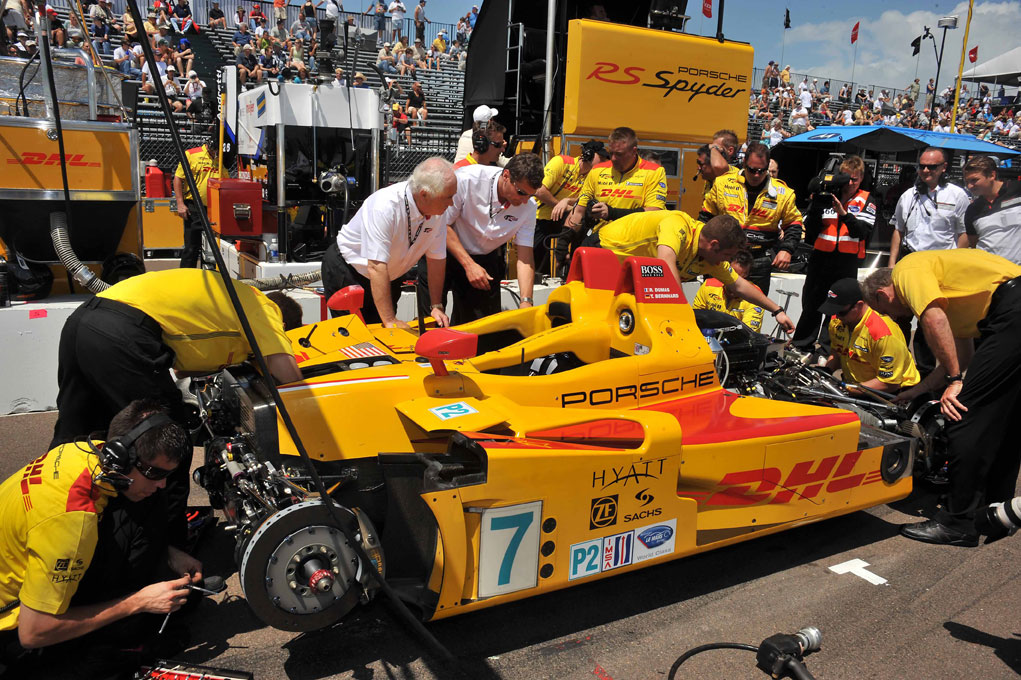Penske Preparation: A key to success
 |
 |
| Roger Penske is right in the thick of things on race weekends |
One of the greatest college basketball coaches of all time, John Wooden once said, “I think very definitely it's the little things that make the big things happen. It's putting your shoes on properly. It's getting the wrinkles out of your socks so you won't get blisters. Those are important things." So how does that relate to motorsport? One of the great “coaches" in the auto racing industry is Roger Penske.
Penske has won 21 national championships in numerous series since his first race win as a driver in 1958. Like Wooden, Roger Penske’s attention to detail and the “little things" play a key role in his success.
On April 4, with eight minutes remaining in the final practice session for the Acura Sports Car Challenge of St. Petersburg, Romain Dumas was piloting the Penske Racing Porsche RS Spyder around the temporary street circuit in downtown St. Petersburg. Dumas made a small mistake and made contact with a GT2 competitor at the treacherous Turn 10. The right rear suspension of the RS Spyder was damaged enough that the car needed a tow back to the pits.
In a normal situation the crew would have hustled back to the paddock area and complete their work there. Not so at St. Petersburg. As at other street circuits, the narrow corridors and concrete walls loom large. In addition the paddock area sat on the outside of the track and gave teams limited access back and forth from the pits to the paddock. As a result, the crew had less than 45 minutes to repair the car before the start of qualifying. And all the work had to be done in the pitstall to have any chance.
That was where the Penske theory of preparation began to shine. The pit stall erupted in what could only be deemed organized chaos. While crew members were diligently watching the in-house television coverage to assess the damage, the other members were collecting the parts like a world class chef preparing to cook a five-star meal. The spare body work and fiberglass components were simple. They were stacked in sequential manner to make final assembly easier. The entire rear wing assembly had to be replaced; a crewmember’s shout that the settings on the wing need to be updated were met with a response that it had already been taken care of after the last change.
 |
| The Penske crew members are all over the Penske Porsche Spyder |
The next problem to deal with was more complicated: the suspension. A carry-on luggage sized box was wheeled from behind the pit stall. The clasps from each side were unbuckled and the entire cover removed. The right rear suspension assembly was revealed; everything from brake pad, brake rotor, and control arm to spare nuts and bolts were included on a small stand. The platform was then placed on the lid creating a working surface. As the teams studied the television monitors, an identical box was revealed in a similar fashion. This time, it bared the left rear suspension piece.
A second crew member appeared with a printed color chart. Studying the spreadsheet he began working on the suspension pieces and tightened bolts with a predetermined precision. After only a few minutes, he was on to the assembly. Behind him on the 3×2-foot piece of concrete pit wall, another crew member was lining sockets, wrenches, drivers and pliers in the same manner a nurse would line a surgical table before intensive surgery. That’s almost what it was.
The car arrived in the pit stall on the back of a flatbed trailer. The drone of the truck’s diesel engine caused the crew members to shout at each other coordinating the delivery of the car. Penske Racing president Tim Cindric paced the pavement, coordinating with his racing family on how to safely land the Porsche to the ground.
With the entire front end removed and the four wheels squared in the pit box, the team began thrashing away. As the damaged parts were taken over the wall, the organized parts were taken away. The damaged parts were catalogued and stacked with as much neatness and organization as the new parts. Roger Penske himself, in his stark white Penske Racing shirt, was a looming presence while the team worked (at least looking in from the outside) effortlessly. He surveyed the damage and assisted in removing body work or holding parts.
Someone reminded Mr. Penske that this group of gentlemen knew what they were doing. His response was simply, “But they’re not doing it fast enough." He then respectfully reminded his team that, “this car will qualify." He returned to his second-story perch atop the transporter stand in the sister pit stall. There he kept a watchful eye as his team was able to complete the repairs in time for qualifying.
The team, trusting in Dumas, put him back in the car with two or three minutes before the prototype qualifying round started. When the green flag waved, the No. 7 car left the pits on a mission. Quickly returning to the pits the following lap, a quick inspection of the car was the only revision needed. It took Dumas just four laps to post his best time in the session. When his 1:03.578 (101.922 mph) went up on the timing screens, the roar from the team was uplifting. High-fives were exchanged along with enthusiastic pats on backs. When the session ended and the team was preparing to cross the now-open track to return to the paddock area, Penske congratulated and shook every person’s grease-covered hand that had a part in the day’s success.
Like coach Wooden said, “It’s the little things…those are the important things."
